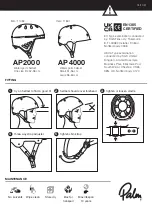
Can line
Function
Allows the communication between the Marelli injection control unit, the instrument panel, the ABS
modulator and the LH lights switch.
Operation / Operating principle
CAN SYSTEM ADVANTAGES
A CAN line (Area network controller) is a connection between various electronic devices of a vehicle,
set up as a computer network (internet). The CAN network allowed to significantly simplify the layout
of the electric system and consequently its total mass. With this communication line, it was possible to
avoid useless duplications of various sensors on the motorcycle, since the signals coming from them
are divided among the three electronic processing units (instrument panel, control unit and ABS mod-
ulator) and the LG light switch.
•
Cable number reduction: The CAN line travels through a twisted cable to several nodes.
•
These nodes can also isolate the errors without causing a system breakdown (FaultsCon-
fination).
•
Immunity to interference: the signal travels through two cables and the signal reading is
differential (voltage difference between the two signals on both cables). If the two signals
are disturbed by an external factor, their difference remains unaltered.
•
Communication speed: The messages travel at a bit rate of approximately 500 kbps (de-
pending on the sent data package, the information may arrive at the nodes in a time carrying
from 4 ms to 100 ms).
CAN PROTOCOL (CONT. NETWORK AREA)
The communication protocol is CSMA/CD (Carrier Sense Multiple Access w/ Collision Detection).
In order to transmit, every nod must first check that the BUS (the connection among all devices) is free
before attempting to send a message with BUS (Carrier Sense).
If during this period there is no activity on BUS, every nod has the same chance to send a message
(Multiple Access). If two nodes start transmitting simultaneously, the nodes recognise the "colli-
sion" (Collision Detection) and initiate an exchange action based on message priority (messages remain
unaltered during exchange and there is no delay for high priority messages).
CAN protocol is based on messages and not on addresses. The message itself is divided into several
parts (frames), each of which has a meaning: message priority, data contained, error detection, recep-
tion confirmation, etc.
Every network nod receives all the messages sent through the BUS (with reception confirmation or error
messages) and each nod decides if the message is to be processed or rejected. Besides, every nod
can request information from the other nodes (RTR = Remote Transmit Request).
Level in electrical circuit diagram:
CAN Line
Electrical system
Tuono V4 1100 Factory
ELE SYS - 260
Summary of Contents for 2Q000504
Page 1: ...SERVICE STATION MANUAL 2Q000504 Tuono V4 1100 Factory ...
Page 4: ......
Page 6: ...INDEX OF TOPICS PRE DELIVERY PRE DE ...
Page 12: ...INDEX OF TOPICS CHARACTERISTICS CHAR ...
Page 55: ...INDEX OF TOPICS SPECIAL TOOLS S TOOLS ...
Page 63: ...INDEX OF TOPICS MAINTENANCE MAIN ...
Page 103: ...INDEX OF TOPICS ELECTRICAL SYSTEM ELE SYS ...
Page 270: ...INDEX OF TOPICS ENGINE FROM VEHICLE ENG VE ...
Page 299: ...INDEX OF TOPICS ENGINE ENG ...
Page 415: ...INDEX OF TOPICS POWER SUPPLY P SUPP ...
Page 425: ...INDEX OF TOPICS SUSPENSIONS SUSP ...
Page 463: ...INDEX OF TOPICS CHASSIS CHAS ...
Page 508: ...INDEX OF TOPICS BRAKING SYSTEM BRAK SYS ...
Page 548: ...INDEX OF TOPICS COOLING SYSTEM COOL SYS ...
Page 561: ...INDEX OF TOPICS BODYWORK BODYW ...
















































